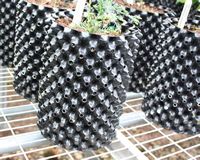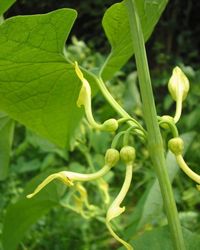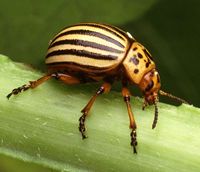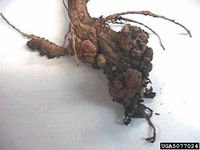This month SCI is holding its annual Members Forum on 28 November at Belgrave Square, London. This is an opportunity to join in the discussions that help to formulate SCI's policies for the future. All members are welcome, and a poster competition is also being held.
On the following day, 29 November, the BioResources Group are holding a meeting entitled 'More Crop per Drop - Raising water use efficiency'. After seven months of above average rainfall it is easy to forget that a year ago we were well into a severe drought. This meeting aims to address the problems raised by water shortages for crop production worldwide and address some of the issues needed to solve the problems.
Crop Protection Monthly is now being offered to all members of the BioResources and Horticulture groups at the special price of £175 + VAT per year, a 20% discount. Subscribers will also receive a copy of CropScene, once every three months. More
Editor
From seed to bark
The Professional Horticulture Group South West organised its October meeting with the general theme of trees. This included a visit to the Forestry Commission's Westonbirt Arboretum, not to delight in the developing autumn colours (although some did) but to see the newly upgraded propagation facilities. Propagator Penny Jones explained that this unit was specifically for propagating the many species and cultivars in the Westonbirt collection as well as new accessions. Some of these come from their own collecting expeditions while others come from expeditions run by Kew and Edinburgh Botanic Gardens.
The wide variety of seed and cutting material requires a highly flexible approach and the facilities have been designed to cope, with glasshouses and polytunnels equipped with mist tunnels and heated benches. Many seeds arrive with little or no indication of how best to propagate them so Penny uses family relationships as a guide although usually trying several different methods to establish the one that is best. Approximately 80% of their production is raised from seed while the remainder comes from cuttings harvested from trees in the arboretum.

We also looked at one of the end products of tree growth, bark, and more specifically its use in growing media. Located only a few miles from Westonbirt, in Gloucestershire, Melcourt Industries has established itself as one of the leading suppliers of premium quality bark and high quality chipped wood and related wood fibre products.
After an introduction we were shown around the Tetbury unit by MD, Andy Chalmers; Technical Director, Catherine Dawson; and Technical Sales Manager, Neil Gray. They explained that Melcourt was a private company 50% owned by A W Jenkinson, a large forestry products company based in Penrith. A W Jenkinson run a large fleet of lorries to deliver their own and Melcourt's products.
The company supplies a large range of grades of bark chippings mainly derived by grading the raw bark supplied from sawmills. Its uses include landscaping, playgrounds, equestrian and reptile bedding. Biofilters are another new and growing market, although we were primarily interested in bark as a growing media base or ingredient. Some coarser grades are used in orchid compost or to ameliorate other composts such as peat, while the finer grades are used in the production of specialist composts for the horticulture industry.
Andy Chalmers was keen to stress that these were not 'muck and magic' but carefully formulated products that were tested for safety and consistency at each stage of production to ensure they

The company is expecting to see an increased demand for peat-free products in the coming year due to the peat shortage that will arise from the difficult harvesting conditions in the very wet summer. In the future the government's planned decline in peat usage will also work in its favour. Nevertheless its ambition is not to over-expand but simply to take a reasonable share of the peat-free market. The Group left impressed by a well-run company with a clear vision.
Plant of the Month
Cattleya bowringiana, Orchidaceae

Cattleyas generally come from Central and South America and are mostly epiphytes with one to three leaves per pseudobulb. This particular species is from Central America, has two leaves per pseudobulb (swollen stem) and is terrestrial rather than epiphytic. It has been over-collected in the wild, but cultivation has saved it from extinction.
Its abundance of flowers per season has drawn it to the attention of orchid hybridisers and there are now over 100 different registered hybrids that use this species as one of the parents. It is hybridised with other Cattleya orchids and also crossed with other closely related genera including Brassavola, Epidendrum and Laelia.
The genus Cattleya was named in honour of William Cattley (1787-1835) of Barnet, England. He was a wealthy patron of botany and an ardent collector of rare plants, who employed John Lindley to describe and draw his plants and had this genus named after him in return. This particular species was first exhibited in London by James Veitch & Sons in 1885 after he discovered it in central America.
Veitch originally named the plant Cattleya autumnalis but later changed the name to C. bowringiana in honour of John C Bowring of Windsor Forest. Bowring (who was a customer of Veitch nurseries) was an avid orchid collector and the eldest son of Queen Victoria's representative in China, Sir John Bowring.
Alison Foster
Oxford Botanic Garden
Medicinal Plant of the Month
Aristolochia clematitis, Aristolochiaceae (birthwort)

The flowers of the genus Aristolochia are sometimes quite spectacular, but often emit a foul smell that attracts pollinating insects. These insects are then trapped in the flower by hairs inside the perianth tube, that eventually wither once the insect is covered in pollen.

Alison Foster
Oxford Botanic Garden
News from our Associates
Commercial Horticultural Association

Society of Biology
Shaping a UK agri-tech strategy: call for evidence
This call for evidence invites you to submit views and information that will help shape a Government strategy to 
The UK has the potential to be at the forefront of developing innovative solutions, and to make fuller use of its agri-science base. Translating fundamental and applied scientific research into innovative technologies, practices and information could enable countries worldwide to meet the food and environmental challenges ahead while also contributing significantly to UK economic growth.
UK Plant Science Federation

Horticulture Industry News
For the very latest horticultural news follow us on Facebook and or
Twitter.
Colorado beetle dislikes clover

In addition, there was no apparent impact of insecticide treatment on Colorado Potato Beetle numbers on eggplant inter-planted with crimson clover compared to plots without. The study team also found that the proportion of Colorado Potato Beetle insect predators was greater in the eggplant plots that were inter-cropped with clover. More
E. coli uses biofilms to survive on plants
In comparing Escherichia coli populations, researchers found that E. coli populations derived from plants tended to form biofilms more readily. Biofilms are complex structures formed by populations of bacteria coming together to make a thin film over a surface. They are held together by a protective extracellular matrix of proteins and sugars, and the researchers saw that there was also an increase in the production of components of this matrix in E. coli derived from the fields. These strains also used sucrose and other plant-derived sugars more than the E. coli populations derived from mammalian sources.
Biofilms might help to prevent E. coli drying out outside of its host and being able to take advantage of plant sugars could also aid their survival outside the main host. However, overall the plant strains showed lower growth on the usual carbon sources E. coli uses. More
Westons World Brands Australia Cider
Westons Cider has bought World Brands Australia (WBA), an Australian drinks distributor, as part of a strategy of consolidating its expanding international business. For several years Westons has had an existing trading relationship with WBA, which acted as the distributor for its brands into the Australian market. The cider market in Australia is growing at +43% volume and +58% value annually and World Brands Australia has been instrumental in placing Westons Cider at the forefront of this growth. More
Lettuce robot kills weeds with fertiliser
A 'Lettuce Bot' has been developed to thin and weed field lettuce crops. Pulled behind a tractor the bot takes pictures of passing plants. Computer-vision algorithms compare these to a database of more than a million images, taken from different angles against different backdrops of soil and other plants. When a plant is identified as a weed - or as a lettuce head that is growing too close to another one - a nozzle at the back of the unit squirts out a concentrated dose of fertiliser.
If this sounds bizarre, it turns out that fertiliser can be as deadly as a pesticide, which is why farmers usually sprinkle it at a safe distance of 10-15cm from the plants to be nourished, so as to dilute its effect. So the robot not only kills weeds and excess heads, but feeds the remaining crops at the same time. More
Woodland warfare in a warming world
Larger invertebrates, such as woodlice, have the strongest impact on the survival of fungi in the soil. The 'grazing pressure' they exert can determine the outcome of battles for dominance between fungal species. When they eat more of the strongest fungal competitor, woodlice save important but less competitive species from being wiped out - maintaining microbial diversity and ensuring that forest floor nutrients are processed efficiently.
The different effects of soil invertebrates on fungal growth and decomposition are important because climate change is predicted to alter their communities. This will indirectly affect the composition of fungal communities, and how quickly they can break down organic matter. Now that we understand more about how these organisms interact, we can begin to consider the impacts of climate change.
Veg box firm joins Jackson's
Organic veg box retailer Abel & Cole has joined the William Jackson Food Group. Best known for its Aunt Bessie's brand the group also includes Hazeldene Foods, specialists in freshly prepared salad leaves and salad vegetables and Parripak Foods, market leaders in the preparation of fresh vegetables.
Plant eating insects can drive the evolution of plants
Scientists have discovered that plants naturally evolve to protect themselves from insect attack, for example from aphids (greenfly and blackfly), but do this as a trade-off with their ability to compete with other plants. They compared the geographic variation in the profiles of glucosinolates (a group of chemical compounds that plants can use to protect themselves) in the plants with the abundance of two specialist aphids from 39 years of field data collected through the Rothamsted Research Insect Survey.
They found that phytophagous (plant-eating) insects may force the rapid evolution of plants through natural selection, with genes resistant to insect attack being favoured. But in areas where the probability of phytophagous insects damage is lower these genes do not appear to be favoured. They argue that this finding 'highlights the potency of natural enemies as selective forces'. More

The obligate soil-borne biotroph Plasmodiophora brassicae, the cause of club root, has a significant economic impact on Brassicaceae crops. The pathogen severely disrupts the roots by inducing the production of galls which leads to malformation and reduced growth of the roots, and a reduced ability to take up water and nutrients. Control of P. brassicae is difficult because it has a number of survival and dissemination strategies that involve both motile and resting stages that need to be targeted by any control agent.
Under controlled conditions in a growth cabinet exogenous application of salicylic acid (SA), the active metabolite of aspirin, to roots resulted in its transport systemically to the leaves where it promoted the up-regulation of the pathogenesis related genes PR-1 and PR-2 in an SAR-like response as early as 24 hours post-treatment. When SA was applied to plants above 5 mm there was a significant reduction (25-65 %) in gall formation six weeks post-inoculation with P. brassicae, indicating that the pathogen was being controlled by the addition of SA. These findings indicate that there may be SA inducible mechanisms in B. oleracea that if fine-tuned could provide enhanced resistance to clubroot disease. More
Tree nuts line path to better medicine
Prescription drugs that today help patients fight severe fungal infections might be even more effective in futue. Laboratory tests suggest that pairing conventional antifungal medications with natural, edible plant compounds such as thymol - extracted from the popular herb thyme - can work synergistically with some of these drugs to boost their healing effects. More and More
Seven-a-day for happiness and mental health
Economists and public health researchers studied the eating habits of 80,000 people in Britain. They found mental well-being appeared to rise with the number of daily portions of fruit and vegetables people consumed. Well-being peaked at seven portions a day. While most western governments currently recommend 'five a day' for cardiovascular health and as protection against cancer risk, in Britain today, a quarter of the population eat just one portion or no portions of fruit and vegetables per day. Only a tenth of the British population currently consume the magic number of seven or more daily portions. Diet has traditionally been ignored by well-being researchers. More
Scientists invent transparent soil to reveal the secret life of plants
It's made from granules of Nafion, which is a lot easier than calling it a sulfonated tetrafluoroethylene based fluoropolymer-copolymer. Used in batteries, fuel cells and a wide range of applications, Nafion is naturally transparent, but in order to make it translucent enough for botanical purposes it needs a special water-based formula. Forming the polymer into pellets allows it to mimic soil particle properties, such as forming channels, retaining water and nutrients and sustaining plant growth. Fluorescent dyes can also be added, to aid studies. More
Midges railroaded by lemon-scented shrubs
Eucalyptus oil has been used to tackle a midge blackspot on the Glasgow-Stranraer rail line in South Ayrshire, used by ScotRail. The infestation was so bad it had caused lights to stop working because of midges homing in on fluorescent tubes and wiring. A 100-mile round trip from Glasgow was needed every fortnight to fix the lights and clear hordes of dead midges covering them. Happily, the insects were driven away by the lemon smell emitted by the lemon eucalyptus plants - Eucalyptus citriodora. More
Events Calendar
Hunting Hotspots
5 Nov, Oxford Botanic Garden
Oxford, UK
CropWorld Global
6 - 8 Nov, British Crop Protection Council
London, UK
GroSouth
7 Nov, Roundstone Nurseries
Chichester, UK
Brassica
12 - 16 Nov, International Society for Horticultural Science
Plant extinctions and the loss of variety
12 Nov, Oxford Botanic Garden
Oxford, UK
Soil & Water Live
13 Nov, Royal Agricultural Society of England
Stoneleigh, UK
Scientific Horticulture
13 - 14 Nov, Slovak University of Agriculture
Nitra, Slovakia
Leafy Salads Conference - Make More Of Salad
14 Nov, British Leafy Salads Association
Peterborough, UK
Food for a fitter future - consumer choice or industry responsibility?
15 Nov, Institute of Food science and Technology
London, UK
Interpoma
15 - 17 Nov, Fiera Bolzano
Bolzano, Italy
Biomolecular Thermodynamics
16 - 17 Nov, Institute of Physics Biological Physics Group
London, UK
Citrus Congress
18 - 23 Nov, International Society for Horticultural Science
Valencia, Spain
Biostimulants
26 - 29 Nov, International Society for Horticultural Science
Strasbourg, France
Crop Protection in Southern Britain
27 - 27 Nov, Association of Applied Biologists
Peterborough, UK
Novel technologies for future pest & disease control in herbs
28 Nov, HDC
Lancaster, UK
Lychee, Longan and Other Sapindaceae Fruits
2 - 7 Dec, International Society for Horticultural Science
White River, South Africa
Integrating Canopy, Rootstock and Environmental Physiology in Orchard Systems
3 - 6 Dec, International Society for Horticultural Science
Stellenbosch, South Africa
Medicinal Plants and Natural Products
3 - 6 Dec, International Society for Horticultural Science
Quito, Ecuador
Crop Genomes and Crop Improvement
5 - 6 Dec, Association of Applied Biologists
Norwich, UK
Good Agricultural Practices (GAP) for Greenhouse Vegetable Production in the Mediterranean Region
9 - 12 Dec, International Society for Horticultural Science
Baqa', Jordan
International Crop Science Conference & Exhibition
6 - 9 Jan, Pesticide Manufacturers Association of India
Nairobi, Kenya
British Herb Trades Association Annual Conference
26 Jan, British Herb Trades Association
Warwick, UK
Lansdcape Industry Show
13 - 14 Feb. California Landscape Contractors Association
Los Angeles, USA
Salon du Vegetal
19 - 21 Feb, Bureau Horticole Régional
Angers, France
New Technologies for Sustainable Agricultural Production and Food Security
24 - 26 Feb, International Society for Horticultural Science
Muscat, Oman
If you would like to advertise a forthcoming event please contact charne.green@soci.org
Horticulture Group Contact Details
For submitting ideas or to volunteer to be part of a committee or a group, please contact:
Chairman - Peter Grimbly
Meetings Secretary - Alison Foster
Minutes Secretary - Margaret Waddy
Newsletter co-ordinator - Sue Grimbly scihortigroup@btinternet.com
Group Contact - Charne Green charne.green@soci.org T: +44 (0)20 7598 1594
